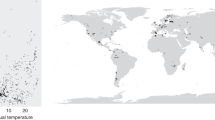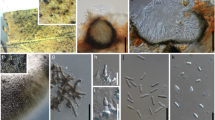Abstract
Although fungi are among the most important organisms in the world, only limited and incomplete information is currently available for most species and current estimates of species numbers for fungi differ significantly. This lack of basic information on taxonomic diversity has significant implications for many aspects of evolutionary biology. While the figure of 1.5 million estimated fungal species is commonly used, critics have questioned the validity of this estimate. Data on biogeographic distributions, levels of endemism, and host specificity must be taken into account when developing estimates of global fungal diversity. This paper introduces a set of papers that attempt to develop a rigorous, minimum estimate of global fungal diversity based on a critical assessment of current species lists and informed predictions of missing data and levels of endemism. As such, these papers represent both a meta-analysis of current data and a gap assessment to indicate where future research efforts should be concentrated.
Similar content being viewed by others
References
Aptroot A (2001) Lichenized and saprobic fungal biodiversity of a single Elaeocarpus tree in Papua New Guinea, with a report of 200 species of ascomycetes associated with one tree. Fungal Divers 6:1–11
Arnold AE, Maynard Z, Gilbert GS, Coley PD, Kursar TA (2000) Are tropical fungal endophytes hyperdiverse? Ecol Lett 3:267–274
Cannon PF (1997) Diversity of the Phyllachoraceae with special reference to the tropics. In: Hyde KD (ed) Biodiversity of tropical microfungi. Hong Kong University Press, Hong Kong, pp 255–278
Crous PW, Rong I, Wood A, Lee S, Glen H, Botha W, Slippers B, de Beer W, Wingfield MJ, Hawksworth DL (2006) How many species of fungi are there at the tip of Africa? Stud Mycol (in press)
Dreyfuss MM, Chapela IH (1994) Potential of fungi in the discovery of novel, low molecular weight pharmaceuticals. In: Gullo V (ed) The discovery of natural products with therapeutic potential. Butterworth Heinemann, London, pp 49–80
Fröhlich J, Hyde KD (1999) Biodiversity of palm fungi in the tropics: are global fungal diversity estimates realistic? Biodivers Conserv 8:977–1004
Guzmán G (1998) Inventorying the fungi of Mexico. Biodivers Conserv 7:369–384
Hammond PM (1992) Species inventory. In: Groombridge B (ed) Global biodiversity: status of the Earth’s Living Resources. Chapman and Hall, London, pp 17–39
Hammond PM (1995) The current magnitude of biodiversity. In: Heywood VH (ed) Global biodiversity assessment. Cambridge University Press, Cambridge, pp 113–138
Hawksworth DL (1991) The fungal dimension of biodiversity: magnitude, significance, and conservation. Mycol Res 95:641–655
Hawksworth DL, Kirk PM, Sutton BC, Pegler DN (1995) Ainsworth and Bisby’s Dictionary of the Fungi, 8th edn. CAB International, Oxon
Hawksworth DL (2001) The magnitude of fungal diversity: the 1.5 million species estimate revisited. Mycol Res 105:1422–1432
Hawksworth DL, Mueller GM (2005) Fungal communities: their diversity and distribution. In: Dighton J, Oudemans P, White J (eds) The fungal community: its organization and role in the ecosystem, 3rd edn. Marcel Dekker, New York, pp 27–37
Hywel-Jones NL (1993) A systematic survey of insect fungi from natural, tropical forest in Thailand. In: Isaac S, Frankland JC, Watling R, Whalley AJS (eds) Aspects of tropical mycology. Cambridge University Press, Cambridge, pp 300–301
May RM (1991) A fondness for fungi. Nature 352:475–476
May RM (1994) Conceptual aspects of the quantification of the extent of biological diversity. Philos Trans R Soc Lond B 345:21–33
May RM (2000) The dimensions of life on Earth. In: Raven PH, Williams T (eds) Nature and Human Society: the quest for a sustainable world. National Academy Press, Washington, pp 30–45
Mueller GM, Bills GF (2004) Introduction. In: Mueller GM, Bills GF, Foster MS (eds) Biodiversity of fungi: inventory and monitoring methods. Elsevier Academic Press, San Diego, pp 1–4
Pascoe IG (1990) History of systematic mycology in Australia. In: Short PS (ed) History of systematic botany in Australia. Australian Systematic Botany Society, South Yarra, pp 259–264
Piepenbring M (2006) Inventoring the fungi of Panama. Biodivers Conserv (this issue)
Rossman A (1994) A strategy for an all-taxa inventory of fungal biodiversity. In: Peng CI, Chou CH (eds) Biodiversity and terrestrial ecosystems. Academia Sinica Monograph Series No. 14. Taipei, pp 169–194
Shivas RG, Hyde KD (1997) Biodiversity of plant pathogenic fungi in the tropics. In: Hyde KD (ed) Biodiversity of tropical microfungi. Hong Kong University Press, Hong Kong, pp 47–56
Smith D, Waller JM (1992) Culture collections of microorganisms: their importance in tropical plant pathology. Fitopatol Bras 17:1–8
Systematics Agenda 2000 (1994) Systematics agenda 2000: charting the biosphere. Technical report. Society of Systematic Biologists, American Society of Plant Taxonomists, Willi Hennig Society, Association of Systematics Collections, New York
Weir A, Hughes M, White MM, Cafaro MJ, Suh S-O, Blackwell M (2002) Biodiversity of arthropod-associated fungi: What do we know? What can we predict? 7th International Mycological Congress, Oslo (abstract, http://www.nhm.uio.no/cgi-bin/imc7_abs.pl?rn=104)
Author information
Authors and Affiliations
Corresponding author
Rights and permissions
About this article
Cite this article
Mueller, G.M., Schmit, J.P. Fungal biodiversity: what do we know? What can we predict?. Biodivers Conserv 16, 1–5 (2007). https://doi.org/10.1007/s10531-006-9117-7
Received:
Accepted:
Published:
Issue Date:
DOI: https://doi.org/10.1007/s10531-006-9117-7




